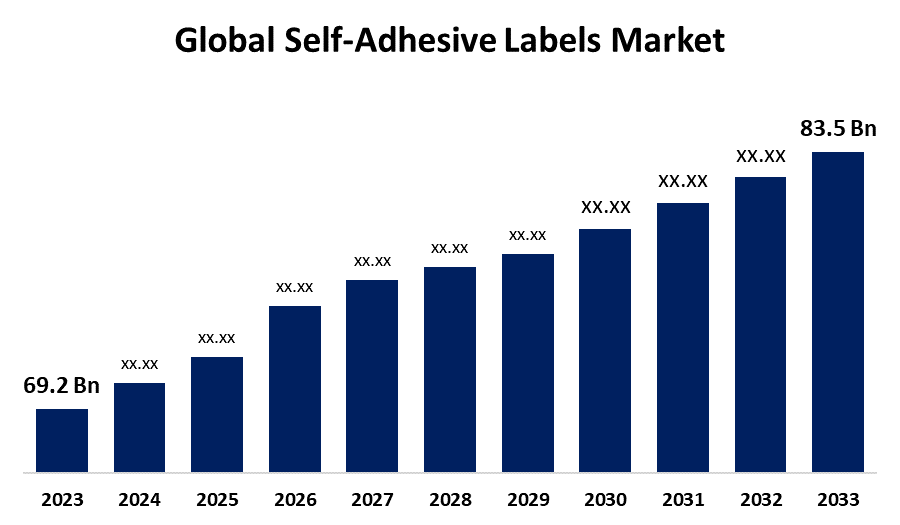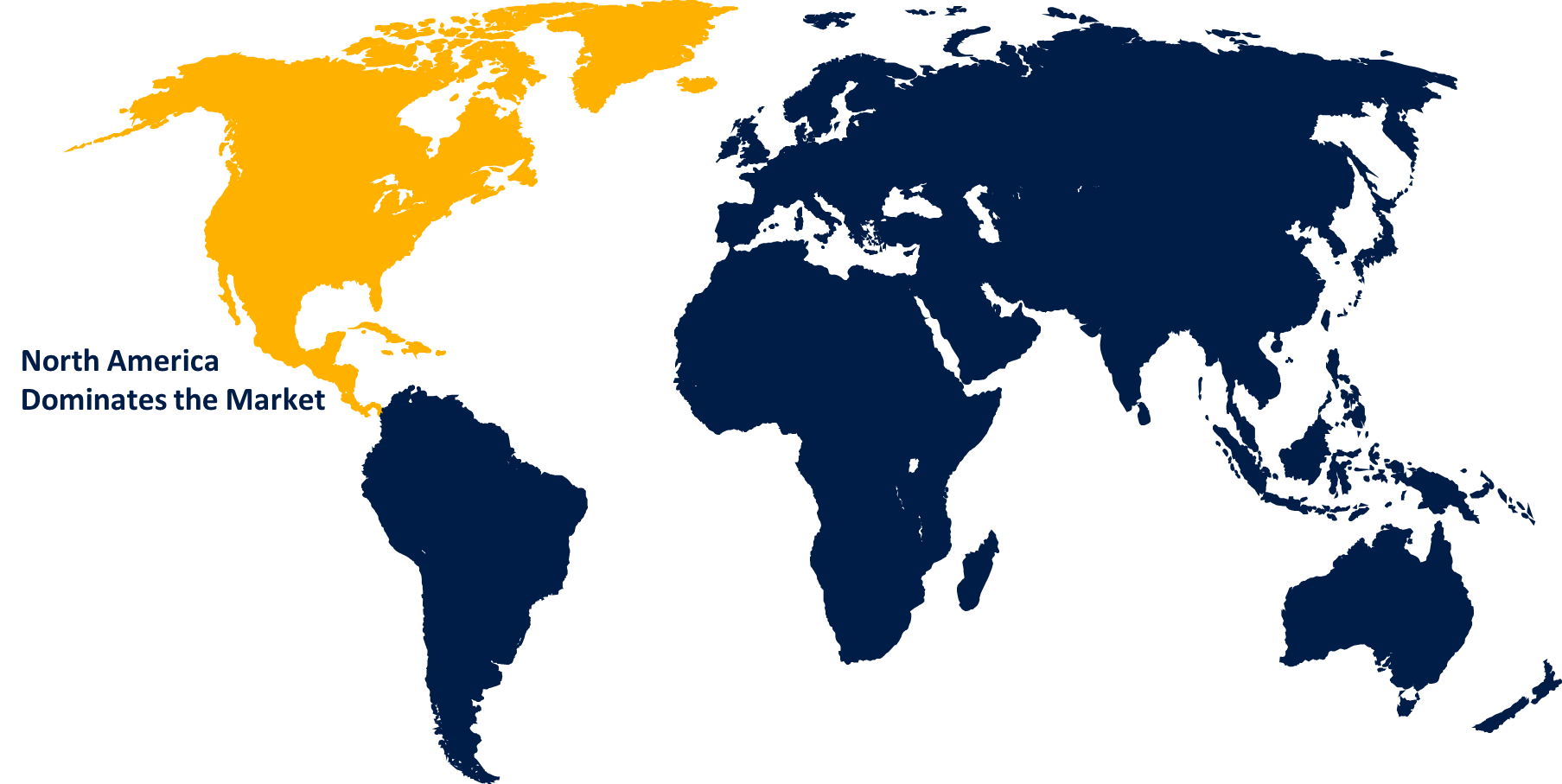Global Self-Adhesive Labels Market Size By Printing Technology (Flexography, Digital Printing, Screen Printing, Gravure), By Application (Food & Beverages, Pharmaceutical, Retail, Home & personal care), By Region, And Segment Forecasts, By Geographic Scope And Forecast Global Self-Adhesive Labels Market Insights Forecasts to 2032
Industry: Chemicals & MaterialsGlobal Self-Adhesive Labels Market Insights Forecasts to 2033
- The Global Self-Adhesive Labels Market Size was valued at USD 69.2 Billion in 2022
- The Market Size is growing at a CAGR of 6.7% from 2022 to 2032
- The Worldwide Self-Adhesive Labels Market Size is expected to reach USD 83.5 Billion by 2032
- Asia Pacific Market is expected to grow the fastest during the forecast period

Get more details on this report -
The Global Self-Adhesive Labels Market Size is expected to reach USD 83.5 Billion by 2032, at a CAGR of 6.7% during the forecast period of 2022–2032.
Market Overview
Self-adhesive labels are typically used to attach to packaging. Labeling technology is a crucial part of the medical and food supply chains. They allow doctors and pharmaceutical companies to provide personalized information to individual patients, as well as facilitate goods tracing and tracking throughout the value chain. These labels provide basic information about the item. They are also used for marketing purposes to gain attention and attract customers. These labels are multifaceted frameworks with data imprinted on a superficial level. Self-adhesive labels consist of three layers: a discharge liner, a layer of glue, and the face material. A discharge liner is primarily made of paper with silicone on one side. Increasing consumer awareness of product ingredients and rising demand for consumer goods are key market drivers. They are a simple, convenient, and time-saving way to label. The rapid expansion of the food, beverage, and pharmaceutical industries is likely to create opportunities for the global label market. Water or other adhesives are not needed for the simple application of self-adhesive labels.
Report Coverage
This research report categorizes the market for the global self-adhesive labels market based on various segments and regions, forecasts revenue growth, and analyzes trends in each submarket. The report analyses the key growth drivers, opportunities, and challenges influencing the global self-adhesive label market. Recent market developments and competitive strategies such as expansion, product launch, and development, partnership, merger, and acquisition have been included to draw the competitive landscape in the market. The report strategically identifies and profiles the key market players and analyses their core competencies in each sub-segment of the global self-adhesive labels market.
Driving Factors
Self-adhesive labels are commonly used to describe the contents, manufacturing date, expiry date, and other product-related information. This factor assists in selecting the appropriate product based on the logo, label description, and instructions. These labels are commonly used in the food and beverage, pharmaceutical, medical, and consumer goods sectors. Global demand for packaged food, clothing, electronics, consumer durables, and non-durable goods is on the rise. The growing population increases demand for consumer goods, and daily use of products contributes to self-adhesive labels market growth. The product is less expensive than other labeling options, such as digital printing, painting, and others. The raw materials needed to make these labels, such as plastic, paper, adhesives, and other materials, are instantly available and inexpensive when compared to digital printing inks used for direct printing. This is one of the factors that will drive the market.
Restraining Factors
Printing directly on packaging surfaces is a constraint for the self-adhesive labels market. While self-adhesive labels are versatile and easy to use, some industries prefer direct printing on packaging materials, which eliminates the need for additional label application steps. This preference for direct printing may limit the market potential for self-adhesive labels, particularly in industries where integrated and cost-effective solutions are valued, and where printing directly on packaging satisfies specific production requirements or regulatory standards.
Market Segmentation
The global self-adhesive labels market share is classified into printing technology, application, and region.
- The flexography segment is expected to hold the largest share of the global self-adhesive labels market during the forecast period.
Based on the printing technology, the global self-adhesive labels market is categorized into flexography, digital printing, screen printing, and gravure. Among these, the flexography segment is expected to hold the largest share of the self-adhesive labels market during the forecast period. Flexographic labels stand out for their durability and resilience. Flexo inks adhere well to a variety of substrates, making labels highly resistant to environmental factors such as moisture, heat, and abrasion. This durability is especially important for labels used in harsh environments, such as chemical, automotive, and outdoor applications. Flexography is expected to remain the leading printing technology in the self-adhesive label market as industries demand more efficient and dependable labeling solutions.
- The food & beverages segment is expected to hold the largest share of the global self-adhesive labels market during the forecast period.
Based on the application, the global self-adhesive labels market is divided into food & beverages, pharmaceutical, retail, and home & personal care. Among this, the food & beverages segment is expected to grow at the fastest pace in the self-adhesive labels market during the forecast period. The emphasis on brand differentiation and consumer engagement has fueled the use of self-adhesive labels in the food and beverage industry. Manufacturers use these labels to establish a distinct brand identity, effectively communicate product information, and engage customers through promotional and marketing messages. The ability of self-adhesive labels to accommodate various shapes, sizes, and design elements contributes to their popularity in helping brands stand out on crowded store shelves.
Regional Segment Analysis of the Global Self-Adhesive Labels Market
- North America (U.S., Canada, Mexico)
- Europe (Germany, France, U.K., Italy, Spain, Rest of Europe)
- Asia-Pacific (China, Japan, India, Rest of APAC)
- South America (Brazil and the Rest of South America)
- The Middle East and Africa (UAE, South Africa, Rest of MEA)
North America is anticipated to hold the largest share of the global self-adhesive labels market over the predicted timeframe.

Get more details on this report -
North America is projected to hold the largest share of the global self-adhesive labels market over the forecast period. Due to the large manufacturing base. The growth of the e-commerce sector in the United States is driving up demand for packaging labels. Furthermore, rising disposable income is expected to drive demand for consumer goods, accelerating the growth of this market. The fast-paced lifestyle of the working population has resulted in a significant increase in demand for consumables, ready-to-eat food, packaged food, and beverages. An increasing need for removable adhesive labels from end-use sectors including food and beverages, packaging, e-commerce, pharmaceuticals, and others will drive market growth in the North American region.
Asia Pacific is projected to grow at the fastest CAGR in the global self-adhesive labels market over the forecast period. Factors such as the easy availability of raw materials and rising demand from various end-use industries may contribute to an increase in the consumer base. Increased manufacturing activities in China and India, owing to the easy availability of raw materials such as adhesives, paper, plastic films, and others, are expected to boost Asia Pacific market growth. Furthermore, densely populated Asia Pacific countries such as India, China, Indonesia, Bangladesh, Japan, and Pakistan have a large consumer base for consumer products such as FMCG, food and beverage, healthcare, and medical products, which will drive regional demand.
Competitive Analysis:
The report offers the appropriate analysis of the key organizations/companies involved within the global self-adhesive labels along with a comparative evaluation primarily based on their product offering, business overviews, geographic presence, enterprise strategies, segment market share, and SWOT analysis. The report also provides an elaborative analysis focusing on the current news and developments of the companies, which includes product development, innovations, joint ventures, partnerships, mergers & acquisitions, strategic alliances, and others. This allows for the evaluation of the overall competition within the market.
List of Key Companies
- Avery Dennison
- CCL Industries
- Multi-Color Corporation
- UPM-Kymmene
- Coveris Holdings S.A.
- Torraspapel Adestor (Part of Lecta Group)
- Fuji Seal International
- Lintec
- Americk Packaging Group
- Inland Label, and Marketing Services
- C.S. Labels
- Secura Labels
- Hansol Paper
- Terragene
- BSP Labels
- Label Craft
- Etiquette Labels
- Reflex Labels
- Muroll
- SVS Spol. S R.O.
- Royston Labels
- Aztec Label
- Etis Slovakia
- Others
Key Target Audience
- Market Players
- Investors
- End-users
- Government Authorities
- Consulting And Research Firm
- Venture capitalists
- Value-Added Resellers (VARs)
Recent Developments
- In January 2021, CCL Industries Inc., a global supplier of specialty labels and packaging to consumers, small and medium-sized businesses, and multinational corporations, announced recently that it has completed two acquisitions for CCL Label and increased its ownership in a joint venture.
- In July 2023, CCL Industries acquired Faubel & Co. Nachfolger GmbH (Germany), which specializes in pharmaceutical label manufacturing.
- In April 2023, the company acquired eAgile Inc., a privately held start-up technology company that offers hardware and software solutions for the healthcare industry, as well as RFID inlays embedded in labels.
- In January 2023, the company announced the acquisition of Thermopatch (US), a market leader in industrial laundry labeling, heat transfers, and textile emblems.
Market Segment
This study forecasts revenue at global, regional, and country levels from 2022 to 2032. Spherical Insights has segmented the global self-adhesive labels market based on the below-mentioned segments:
Global Self-Adhesive Labels Market, Printing Technology Analysis
- Flexography
- Digital Printing
- Screen Printing
- Gravure
Global Self-Adhesive Labels Market, Application Analysis
- Food & Beverages
- Pharmaceutical
- Retail
- Home & personal care
Global Self-Adhesive Labels Market, By Region
- North America
- US
- Canada
- Mexico
- Europe
- Germany
- Uk
- France
- Italy
- Spain
- Russia
- Rest of Europe
- Asia Pacific
- China
- Japan
- India
- South Korea
- Australia
- Rest of Asia Pacific
- South America
- Brazil
- Argentina
- Rest of South America
- Middle East & Africa
- UAE
- Saudi Arabia
- Qatar
- South Africa
- Rest of the Middle East & Africa
Need help to buy this report?